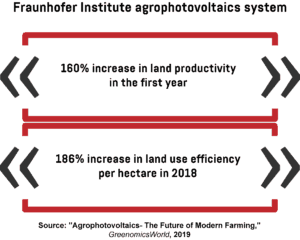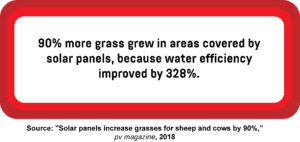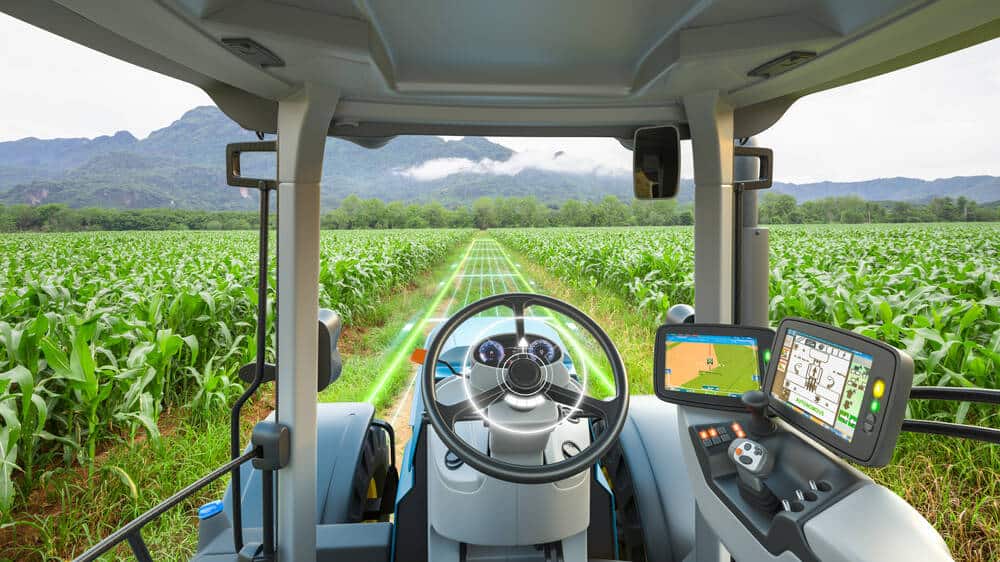- The Fraunhofer Institute’s agrophotovoltaic system increased land productivity by 160 per cent
- Solar modules boost grass growth
- The University of Arizona plans to install an agrivoltaic system on its ENR2 building
- Agrivoltaics could help land-scarce countries produce more energy and food
- Benefits and challenges
- The future of modern farming
The growing global population, coupled with the shortage of arable land, could mean that we’re heading for a food crisis in the future. This, unfortunately, isn’t the only challenge our society has to deal with. Another problem lies in our high reliance on fossil fuels. Both of these issues could have devastating effects on our environment and humanity in general.
Researchers and experts have spent the last couple of years working on solutions to overcome these challenges, but they’re mostly focused on addressing the two issues separately. However, there’s an innovative approach that relies on ‘agrivoltaics’ – the concept of fusing solar energy production with farming – which could change the way we produce food and energy in the future.
Though it’s not a novelty, agrivoltaics has recently started gaining more traction. The approach is quite simple, and it consists of installing solar panels on farmland to produce renewable energy and boost crop yields. As the price of solar panel tech becomes more affordable, agrivoltaics could set the foundations for future farms.
The Fraunhofer Institute’s agrophotovoltaic system increased land productivity by 160 per cent
The Fraunhofer Institute has been conducting ‘agrophotovoltaics’ experiments near Lake Constance in Germany, where researchers installed 720 bi-facial solar panels on farmland. These solar panels are more efficient than traditional designs, because they can capture sunlight from both their front and back side. To prevent the panels from disturbing crop growth, the structure was placed five metres above the ground. This allowed the plants to get enough sunlight, and farm machinery to operate on the land with no difficulty. After one year of testing, the team discovered that combining agriculture with solar energy tech increased land productivity by 160 per cent.

The experiment was conducted on various crops, including potatoes, winter wheat, clover grass, and celeriac. The team was also able to use solar power to operate electric farm equipment. The rest of the produced power was sold to an energy utility company called Elektrizitätswerke Schönau. “Based on the 2018 potato yield, the land use efficiency rose to 186% per hectare with the agrophotovoltaic system,” points out Stephan Schindele of Fraunhofer ISE.
Before their technology gets commercialised on the market, though, the researchers will need to conduct more experiments to test larger systems and prove their technological and economic potential, as well as transferability to other regions. “From the perspective of agricultural science, agrophotovoltaics is a promising solution for increasing both the land use efficiency and the share of renewable energy provided by the agricultural sector,” says professor Iris Lewandowski, the head of the department of biobased products and energy crops at the University of Hohenheim.
Solar modules boost grass growth
Another experiment showed positive results in using solar panels on farmland. In 2018, experts from Oregon State’s College of Agricultural Sciences revealed the results of a study showing that solar modules could increase agricultural production on dry and unirrigated land. As part of the study, the researchers measured different variables, including air temperature, humidity, soil moisture, and wind speed and direction. Based on the analysis, the team found that solar modules increased water efficiency, since plants that were grown below solar panels required less water. According to pv magazine, this resulted in 90 per cent more grass growing in areas covered with solar panels.

What’s surprising is that the researchers never intended to use solar arrays to grow crops. When they installed the solar panels on the university’s campus, the goal was only to produce energy. But when Chad Higgins, an associate professor at the University’s Department of Biological and Ecological Engineering, and his colleagues casually walked past the solar farm one day, they noticed that grass has been growing below the panels. After doing some research, the team discovered that the soil beneath the panels had higher levels of moisture than the soil exposed directly to the sun. In other words, plants that grow in full sun need more water. Those plants grow to the extent they can, and then die afterwards. “On the other hand, the plants in the shade take sips of water because they are less stressed, and they keep chugging along,” notes professor Higgins. The study included monitoring the growth of grass, commonly used as food for sheep and cattle. However, the researchers have plans to test this concept on high-value crops, which can grow in shady conditions. “There are some plants that are happier in shaded environments,” Higgins says. “The amount of water that went into the making those plants is tremendously smaller than in the open field. You get double the yield, less water and all the solar energy.”
The University of Arizona plans to install an agrivoltaic system on its ENR2 building
Many other institutions are experimenting with agrivoltaic technology. To help meet humanity’s energy and food needs, the University of Arizona plans to install an agrivoltaic unit on the roof of the Environment and Natural Resources 2 (ENR2) building. The installation is expected to take place in the summer of 2019.

The University of Arizona already has a solar system installed on its campus, but the new system could increase the amount of renewable energy produced on the campus by 20 per cent, which will improve sustainability on a larger scale. It’s been revealed that the project could generate 50,000 kWh of electricity annually.
As for the environment, this could eliminate more than 1,040 tonnes of carbon emissions. At the same time, the project could provide significant cost savings in utility bills in the future. The plan is to use the area below the solar panels to cultivate shade-tolerant plants. Since the system will provide shade from the sun, this will improve plant growth. Moreover, students and community members will be able to take part in guided tours and learn more about agrivoltaics.
Agrivoltaics could help land-scarce countries produce more energy and food
Agrivoltaics could be particularly helpful for regions that are coping with land scarcity. In the US state of Massachusetts, for instance, high costs of land and labour are making farming a less desirable business. And although the state wants to increase its renewable energy capacity, its high population density is increasing land scarcity, which prevents the further development of solar energy projects. Usually, when solar developers get farmland for their projects, they remove the topsoil and install concrete footings on the land to hold the panels. As such, the land can only be used to host solar farms.
But if the land is used to produce food and energy at the same time, Massachusetts’ authorities could fulfil its plans. For this reason, the University of Massachusetts Crop Research and Education Center installed solar panels 2.1 metres above the ground. Unlike a conventional solar farm, panels installed at the University of Massachusetts aren’t clustered together. Beneath the panels, farmers are growing leafy kale and brussels sprouts. The tech is still in the early stages, but Brad Mitchell, a deputy executive director at the Massachusetts Farm Bureau Federation, thinks it could be a great thing for farmers. “You get to farm and use the same exact space to generate money from solar production,” explains Mitchell.
Benefits and challenges
Clearly, for areas suffering from water and land scarcity, agrivoltaics is the perfect solution. Plants growing beneath solar panels need minimal water. With less resources, farmers will still have higher yields and better land efficiency. Besides environmental benefits, this brings huge economic benefits as well. It’s becoming more expensive to operate coal plants, which isn’t the case with renewable energy such as solar. In the US, for instance, 74 per cent of the country’s coal plants “could be phased out for renewable energy”.
The only thing that’s preventing most farmers from experimenting with agrivoltaics is the high installation cost of solar panels. But this investment will pay off in the long run, because farmers will not only produce more food, but also generate free and green energy. Farmers will no longer be surprised by unexpected power failures, since the energy captured from sunlight will be stored using batteries, making the farm completely energy-independent. As climate change is taking a serious toll on farmers, agrivoltaics will be their way of fighting against its dangerous effects.
The future of modern farming
With the rise of global temperatures, farmers are facing serious issues. What’s more, the global population, and with it, the demand for food are growing. Though it’s not widely used like other types of farming, agrivoltaics could completely revolutionise agriculture. The concept is built on the idea that agriculture and renewable energy can work together. Farmland can be used to harvest food and energy at the same time, which will provide farmers with additional income and bring power enhancements to the grid. With more efficient and cost-effective battery storage solutions, farmers will be able to make better use of their solar food farms. There’s no doubt that farmers will reap the benefits of cutting-edge technology in the future.








